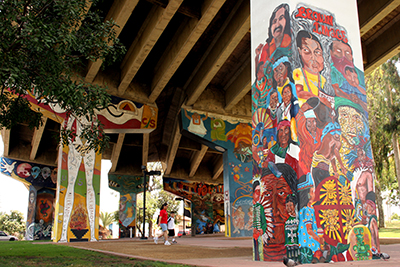1.4.3: Los Chicanos
- Page ID
- 226840
\( \newcommand{\vecs}[1]{\overset { \scriptstyle \rightharpoonup} {\mathbf{#1}} } \)
\( \newcommand{\vecd}[1]{\overset{-\!-\!\rightharpoonup}{\vphantom{a}\smash {#1}}} \)
\( \newcommand{\id}{\mathrm{id}}\) \( \newcommand{\Span}{\mathrm{span}}\)
( \newcommand{\kernel}{\mathrm{null}\,}\) \( \newcommand{\range}{\mathrm{range}\,}\)
\( \newcommand{\RealPart}{\mathrm{Re}}\) \( \newcommand{\ImaginaryPart}{\mathrm{Im}}\)
\( \newcommand{\Argument}{\mathrm{Arg}}\) \( \newcommand{\norm}[1]{\| #1 \|}\)
\( \newcommand{\inner}[2]{\langle #1, #2 \rangle}\)
\( \newcommand{\Span}{\mathrm{span}}\)
\( \newcommand{\id}{\mathrm{id}}\)
\( \newcommand{\Span}{\mathrm{span}}\)
\( \newcommand{\kernel}{\mathrm{null}\,}\)
\( \newcommand{\range}{\mathrm{range}\,}\)
\( \newcommand{\RealPart}{\mathrm{Re}}\)
\( \newcommand{\ImaginaryPart}{\mathrm{Im}}\)
\( \newcommand{\Argument}{\mathrm{Arg}}\)
\( \newcommand{\norm}[1]{\| #1 \|}\)
\( \newcommand{\inner}[2]{\langle #1, #2 \rangle}\)
\( \newcommand{\Span}{\mathrm{span}}\) \( \newcommand{\AA}{\unicode[.8,0]{x212B}}\)
\( \newcommand{\vectorA}[1]{\vec{#1}} % arrow\)
\( \newcommand{\vectorAt}[1]{\vec{\text{#1}}} % arrow\)
\( \newcommand{\vectorB}[1]{\overset { \scriptstyle \rightharpoonup} {\mathbf{#1}} } \)
\( \newcommand{\vectorC}[1]{\textbf{#1}} \)
\( \newcommand{\vectorD}[1]{\overrightarrow{#1}} \)
\( \newcommand{\vectorDt}[1]{\overrightarrow{\text{#1}}} \)
\( \newcommand{\vectE}[1]{\overset{-\!-\!\rightharpoonup}{\vphantom{a}\smash{\mathbf {#1}}}} \)
\( \newcommand{\vecs}[1]{\overset { \scriptstyle \rightharpoonup} {\mathbf{#1}} } \)
\( \newcommand{\vecd}[1]{\overset{-\!-\!\rightharpoonup}{\vphantom{a}\smash {#1}}} \)
\(\newcommand{\avec}{\mathbf a}\) \(\newcommand{\bvec}{\mathbf b}\) \(\newcommand{\cvec}{\mathbf c}\) \(\newcommand{\dvec}{\mathbf d}\) \(\newcommand{\dtil}{\widetilde{\mathbf d}}\) \(\newcommand{\evec}{\mathbf e}\) \(\newcommand{\fvec}{\mathbf f}\) \(\newcommand{\nvec}{\mathbf n}\) \(\newcommand{\pvec}{\mathbf p}\) \(\newcommand{\qvec}{\mathbf q}\) \(\newcommand{\svec}{\mathbf s}\) \(\newcommand{\tvec}{\mathbf t}\) \(\newcommand{\uvec}{\mathbf u}\) \(\newcommand{\vvec}{\mathbf v}\) \(\newcommand{\wvec}{\mathbf w}\) \(\newcommand{\xvec}{\mathbf x}\) \(\newcommand{\yvec}{\mathbf y}\) \(\newcommand{\zvec}{\mathbf z}\) \(\newcommand{\rvec}{\mathbf r}\) \(\newcommand{\mvec}{\mathbf m}\) \(\newcommand{\zerovec}{\mathbf 0}\) \(\newcommand{\onevec}{\mathbf 1}\) \(\newcommand{\real}{\mathbb R}\) \(\newcommand{\twovec}[2]{\left[\begin{array}{r}#1 \\ #2 \end{array}\right]}\) \(\newcommand{\ctwovec}[2]{\left[\begin{array}{c}#1 \\ #2 \end{array}\right]}\) \(\newcommand{\threevec}[3]{\left[\begin{array}{r}#1 \\ #2 \\ #3 \end{array}\right]}\) \(\newcommand{\cthreevec}[3]{\left[\begin{array}{c}#1 \\ #2 \\ #3 \end{array}\right]}\) \(\newcommand{\fourvec}[4]{\left[\begin{array}{r}#1 \\ #2 \\ #3 \\ #4 \end{array}\right]}\) \(\newcommand{\cfourvec}[4]{\left[\begin{array}{c}#1 \\ #2 \\ #3 \\ #4 \end{array}\right]}\) \(\newcommand{\fivevec}[5]{\left[\begin{array}{r}#1 \\ #2 \\ #3 \\ #4 \\ #5 \\ \end{array}\right]}\) \(\newcommand{\cfivevec}[5]{\left[\begin{array}{c}#1 \\ #2 \\ #3 \\ #4 \\ #5 \\ \end{array}\right]}\) \(\newcommand{\mattwo}[4]{\left[\begin{array}{rr}#1 \amp #2 \\ #3 \amp #4 \\ \end{array}\right]}\) \(\newcommand{\laspan}[1]{\text{Span}\{#1\}}\) \(\newcommand{\bcal}{\cal B}\) \(\newcommand{\ccal}{\cal C}\) \(\newcommand{\scal}{\cal S}\) \(\newcommand{\wcal}{\cal W}\) \(\newcommand{\ecal}{\cal E}\) \(\newcommand{\coords}[2]{\left\{#1\right\}_{#2}}\) \(\newcommand{\gray}[1]{\color{gray}{#1}}\) \(\newcommand{\lgray}[1]{\color{lightgray}{#1}}\) \(\newcommand{\rank}{\operatorname{rank}}\) \(\newcommand{\row}{\text{Row}}\) \(\newcommand{\col}{\text{Col}}\) \(\renewcommand{\row}{\text{Row}}\) \(\newcommand{\nul}{\text{Nul}}\) \(\newcommand{\var}{\text{Var}}\) \(\newcommand{\corr}{\text{corr}}\) \(\newcommand{\len}[1]{\left|#1\right|}\) \(\newcommand{\bbar}{\overline{\bvec}}\) \(\newcommand{\bhat}{\widehat{\bvec}}\) \(\newcommand{\bperp}{\bvec^\perp}\) \(\newcommand{\xhat}{\widehat{\xvec}}\) \(\newcommand{\vhat}{\widehat{\vvec}}\) \(\newcommand{\uhat}{\widehat{\uvec}}\) \(\newcommand{\what}{\widehat{\wvec}}\) \(\newcommand{\Sighat}{\widehat{\Sigma}}\) \(\newcommand{\lt}{<}\) \(\newcommand{\gt}{>}\) \(\newcommand{\amp}{&}\) \(\definecolor{fillinmathshade}{gray}{0.9}\)El término “chicano/a”

En su libro Chicano Folklore, Rafaela Castro explica que un chicano es una persona de ascendencia mexicana nacida en los EE.UU. Muchos mexicano-americanos nacidos en los Estados Unidos se consideran chicanos para enfatizar e identificar su herencia mexicana e indígena. Castro señala que hay varios mitos del origen de la palabra. Algunos dicen que el término viene del estado mexicano Chihuahua y la palabra mexicano (Chihuahua / Mexicano → Chicano) (46). Otras personas piensan que la palabra “chicano” es de origen náhuatl, el idioma principal de los aztecas. Ellos le llamaban a su territorio Mexica (pronunciado [me'shi.ka]), una palabra que suena muy similar a “chicano”.
En los 1960s los jóvenes y los estudiantes universitarios empezaron a utilizar “chicano/a” en sus movimientos políticos para demostrar su identidad cultural. Como señala Castro, Chicano/a “has become an ideologically loaded symbolic code word that expresses cultural pride in a common Mexican heritage. To call oneself Chicano symbolizes a solidarity with the Spanish language and with a pre-Columbian indigenous past, and an understanding of American racial oppression and discrimination against Mexican-Americans” (46). Por esto, el término tiene tanto que ver con ser mexicano-americano como con la posición política de una persona.
El movimiento chicano
El Movimiento Chicano comenzó en los años 1960s con el deseo de mejorar el tratamiento de mexicano-americanos en varios sectores: la política, la educación, y el trabajo –– especialmente en los campos agrícolas. Este movimiento se inspiró en parte por el movimiento de derechos civiles dirigido por Martin Luther King Jr. y ganó mucho apoyo entre los estudiantes universitarios, quienes empezaron a interesarse en su identidad y a valorar su herencia indígena mexicana. Uno de estos grupos se llama MEChA, Movimiento Estudiantil Chicano de Aztlán. Aztlán es el nombre del antiguo territorio de los aztecas.
Un líder importante en el movimiento de los trabajadores agrícolas fue César Chávez, quien luchó durante toda su vida por los derechos de mexicano-americanos. Chávez nació en Yuma, Arizona de padres que vivían como campesinos migratorios. En 1962, él creó el sindicato “United Farm Workers” (UFW) para mejorar los derechos y las condiciones de los trabajadores. En 1965 organizó una huelga para obtener mejores contratos para los trabajadores. El Movimiento Chicano promociona la identidad de los mexicano-americanos e intenta corregir los estereotipos negativos de los mexicanos en los Estados Unidos sin emplear la violencia. Aunque Chávez falleció en 1993, UFW sigue trabajando para mejorar las condiciones en los campos.
Expresiones artísticas chicanas

Desde 1960, las expresiones artísticas chicanas han sido herramientas de activismo político y han ayudado a crear un sentido de comunidad entre los mexicano-americanos. Los enlaces a continuación incluyen ejemplos de los artistas que jugaron un papel importante cuando el movimiento comenzó en 1960 pero también de artistas más recientes que rompen con los moldes tradicionales.
El arte chicano
La meta de la nueva generación de chicanos es criticar y denunciar los estereotipos negativos sobre los mexicano-americanos y defender los derechos de los inmigrantes.
La música chicana
La literatura chicana
Tradicionalmente, la literatura chicana explora temas como la identidad, el biculturalismo, el bilingüismo, y la vida en la frontera. Autores chicanos incluyen a Rudolfo Anaya, Sandra Cisneros, y Lorna Dee Cervantes. En 2003, Alisa Valdes-Rodriguez publicó una novela de “Chica lit’ que se llama The Dirty Girls Social Club. Esta novela representa una ruptura con la literatura chicana tradicional. Como dice Valdes-Rodriguez en el artículo, “"I'm an Ivy League graduate, middle-class person who just lives a regular American life — you know, born and raised here, don't speak all that much Spanish — and there are lots and lots of people like me."”
El cine chicano
- What Does It Mean To Be Chicano?
- History of Chicano Cinema’s Rise
- Stereotypes in the Media
- What Coco Means to Mexican-Americans
(Fuentes: Castro, Rafaela. Chicano Folklore. Oxford UP, 2000).
Almanaque creado por Karen Acosta y modificado por Mirla González.


